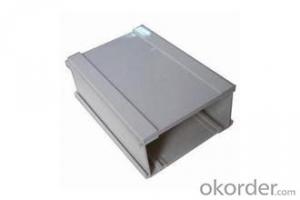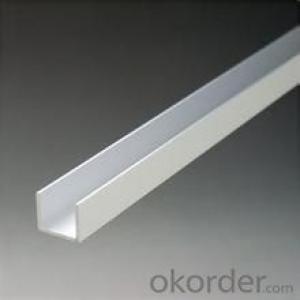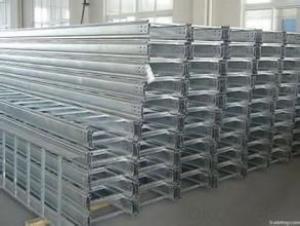Aluminum Section H cable tray
- Loading Port:
- China Main Port
- Payment Terms:
- TT OR LC
- Min Order Qty:
- -
- Supply Capability:
- -
OKorder Service Pledge
OKorder Financial Service
You Might Also Like
Aluminium is a relatively soft,durable, lightweight, ductile and malleablemetal with appearance ranging from silvery to dull gray,depending on the surface roughness. It is nonmagnetic and does not easilyignite. A fresh film of aluminium serves as a good reflector (approximately92%) of visible light and an excellent reflector (as much as98%) of medium and far infrared radiation. The yield strength of pure aluminium is 7–11 MPa,while aluminium alloys have yield strengths ranging from200 MPa to 600 MPa. Aluminium has about one-third the density and stiffnessof steel. It iseasily machined,cast, drawn and extruded.
Alu Profile:
Material | Alloy 6063,6061,6005or according to customer’s choice |
Temper | T3, T4, T5, T6 |
Surface | Anodize, electrophoresis, powder coating, PVDF coating, wood grain painting, matted, etc. |
Length | Coating 6.5 meters, Anodizing 6.5 meters, Mill finish 5 meters |
Application | Industrial, electrical equipment(TV set, air conditioner, refrigerator, computer), decoration,construction, transportation |
Custom Made | We can package following with customer's request. |
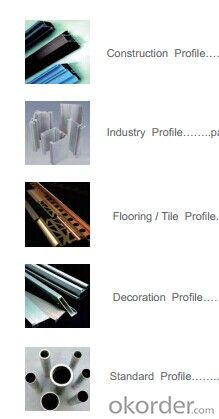
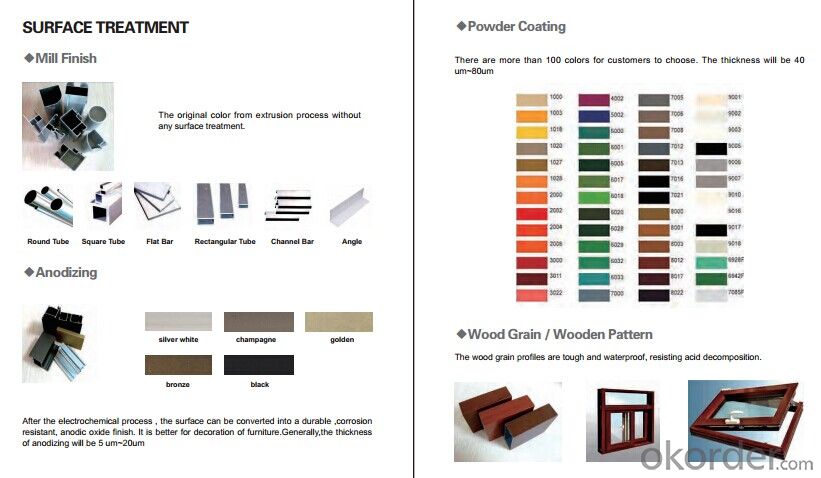

FAQ:
1. What is the form of payment?
Normally 30% TT, L/C at sight
2. Type of quotation?
FOB, CFR, CIF
3. Port of loading?
Guangzhou/Shenzhen port
4. Delivery time?
15-20 days after client’s deposit
- Q:How do aluminum profiles perform in terms of electrical conductivity?
- Aluminum profiles have relatively low electrical conductivity compared to other metals such as copper or silver. This is due to the fact that aluminum has a higher resistivity, meaning it offers more resistance to the flow of electric current. However, aluminum profiles still possess sufficient electrical conductivity for many applications. They can effectively conduct electricity, making them suitable for various electrical and electronic devices. Additionally, aluminum profiles can be specially treated or coated to enhance their conductivity if needed.
- Q:What is the HS code for aluminum profile?
- What type of aluminum? Fluorocarbon polymer sprayed aluminum profile HS Code: 7606 anodized aluminum profile, custom HS code 7604, the total is unclear
- Q:Are aluminum profiles suitable for cleanroom partitions?
- Yes, aluminum profiles are suitable for cleanroom partitions. They offer a lightweight and durable solution that is resistant to corrosion and easy to clean, making them ideal for maintaining a clean and sterile environment in cleanrooms. Additionally, aluminum profiles can be customized to fit specific requirements, allowing for flexibility in design and construction.
- Q:What are the different surface patterns available for aluminum profiles?
- Aluminum profiles offer a variety of surface patterns, each with unique advantages in terms of appearance and function. The options include: 1. Smooth: This basic pattern features a polished finish, providing a sleek and modern look suitable for applications where aesthetics matter. 2. Brushed: This pattern showcases fine lines or brush strokes in one direction, creating a textured, satin-like appearance popular in contemporary and industrial designs. 3. Anodized: Anodizing is an electrochemical process that results in a durable, corrosion-resistant surface. It can be tailored to achieve different colors and finishes, such as matte, glossy, or metallic. 4. Powder-coated: This technique involves applying dry powder to the aluminum surface, which is then heated to create a smooth and long-lasting finish. It allows for a wide array of colors and textures, including matte, glossy, and textured options. 5. Wood grain: Specialized printing techniques can mimic the look of wood on aluminum profiles. This pattern offers the warm and natural appearance of wood while retaining the durability and low maintenance of aluminum. 6. Textured: Aluminum profiles can also feature a range of textures, from fine sand-like patterns to more pronounced embossed or hammered looks. Textured surfaces not only enhance visual appeal but also provide improved grip and slip resistance. These examples represent just a few of the available surface patterns for aluminum profiles. The choice of pattern depends on specific application requirements, desired aesthetics, and functional needs.
- Q:What are the different shapes available in aluminum profiles?
- There are various shapes available in aluminum profiles, each designed to serve specific purposes and meet different structural requirements. Some common shapes include: 1. T-shape: This profile has a T-shaped cross-section, with a horizontal section and a vertical section. It is often used to create joints, connections, or support structures. 2. U-shape: This profile has a U-shaped cross-section, with two parallel sides and an open bottom. It is commonly used for framing, edging, or as a protective barrier. 3. L-shape: As the name suggests, this profile has an L-shaped cross-section, with one side longer than the other. It is frequently used for corner brackets, supports, or to create right-angle connections. 4. Square shape: These profiles have a square cross-section, with all sides equal in length. Square profiles are versatile and can be used for a wide range of applications, such as framing, rails, or supports. 5. Round shape: This profile has a circular cross-section, making it ideal for applications that require rounded edges or a seamless look. It is commonly used for handrails, decorative purposes, or in the automotive industry. 6. Rectangular shape: These profiles have a rectangular cross-section, with two longer sides and two shorter sides. They are often utilized for structural framing, supports, or as beams. 7. I-beam shape: Also known as an H-beam, this profile has an I-shaped cross-section with a central vertical web and two horizontal flanges. I-beams offer excellent strength and are commonly used in construction, bridges, or industrial applications. 8. Channel shape: This profile has a U-shaped cross-section with one side shorter than the other. It is widely used for structural support, framing, or as tracks for sliding doors and windows. These are just a few examples of the various shapes available in aluminum profiles. The choice of shape depends on the specific requirements of the project, such as load-bearing capacity, design aesthetics, or functionality.
- Q:Are aluminum profiles suitable for solar panel frames?
- Solar panel frames made from aluminum profiles are an excellent option. Aluminum is a lightweight material that is also strong, making it perfect for constructing solar panel frames. It offers exceptional resistance to corrosion, which is crucial for outdoor use, ensuring that the frames last a long time. Additionally, aluminum profiles can be easily shaped and formed, allowing for flexible and customizable designs that can accommodate various solar panel sizes and configurations. Moreover, aluminum is highly sustainable as it is completely recyclable, aligning with the environmentally-friendly nature of solar energy. In summary, using aluminum profiles for solar panel frames provides numerous benefits such as strength, durability, corrosion resistance, flexibility, and sustainability, making it an extremely suitable choice.
- Q:Can aluminum profiles be used for DIY projects or home improvement?
- Yes, aluminum profiles can be used for DIY projects or home improvement. Aluminum profiles are versatile and can be easily cut, shaped, and joined together to create various structures and components for different applications. They are lightweight, yet strong and durable, making them suitable for a wide range of projects. Whether you want to build a custom shelving unit, construct a garden fence, create a frame for a solar panel, or even design a unique piece of furniture, aluminum profiles can be an excellent choice. Additionally, they are resistant to corrosion and require minimal maintenance, which makes them ideal for outdoor projects as well. With the right tools and a little creativity, aluminum profiles can be transformed into functional and aesthetically pleasing additions to your home.
- Q:What are the fire-resistant properties of aluminum profiles?
- Aluminum profiles possess several fire-resistant properties that make them a suitable choice for various applications. First and foremost, aluminum has a high melting point of approximately 660 degrees Celsius (1220 degrees Fahrenheit), which means it can withstand high temperatures without melting or losing its structural integrity. Moreover, aluminum has a low ignition point, meaning it requires a higher temperature to ignite compared to other metals. This property makes it less susceptible to catching fire when exposed to heat or flames. In the event of a fire, aluminum profiles form a protective layer of aluminum oxide on their surface due to their natural oxide layer. This layer acts as a barrier, preventing the further spread of flames and inhibiting the combustion process. Additionally, the aluminum oxide layer is highly heat resistant, providing additional protection against high temperatures. Furthermore, aluminum profiles are non-combustible, meaning they do not contribute to the spread of fire. This characteristic is crucial in fire safety as it helps to contain the fire within a specific area and prevent its rapid expansion. Overall, the fire-resistant properties of aluminum profiles, including high melting point, low ignition point, the formation of a protective oxide layer, and non-combustibility, make them a reliable choice for various applications where fire safety is a concern.
- Q:Are aluminum profiles suitable for furniture applications?
- Yes, aluminum profiles are suitable for furniture applications. Aluminum is a lightweight and durable material that can be easily shaped and manipulated to create various furniture designs. It provides stability and strength to furniture pieces while also offering a sleek and modern aesthetic. Additionally, aluminum is resistant to rust and corrosion, making it suitable for both indoor and outdoor furniture applications.
- Q:How do I maintain and clean aluminum profiles?
- Achieving and upholding the cleanliness and maintenance of aluminum profiles can be accomplished by adhering to the following guidelines: 1. Consistent dusting is key: Commence by employing a gentle cloth or feather duster to eliminate loose dust or dirt. This will hinder the accumulation of grime and simplify the subsequent cleaning process. 2. Create a cleaning solution: Combine warm water with a mild detergent or dish soap in either a bucket or spray bottle. It is important to avoid the usage of harsh chemicals or abrasive cleaners, as they have the potential to cause damage to the aluminum surface. 3. Thoroughly clean the profiles: Immerse a soft cloth or sponge into the cleaning solution and delicately scrub the aluminum profiles. Particular attention should be given to areas that exhibit stains or stubborn dirt. 4. Rinse with fresh water: Subsequent to cleaning, it is crucial to thoroughly rinse the profiles with clean water to eliminate any residual soap or cleaning solution. This step is essential in preventing the formation of streaks or marks caused by dried residue. 5. Dry the profiles: Employ a soft, dry cloth or towel to meticulously wipe the aluminum profiles until they are completely dry. This will help prevent the formation of water spots and preserve the metallic shine. 6. Optional polishing: If desired, a non-abrasive aluminum polish can be applied to further enhance the shine and safeguard the surface. For optimal results, adhere to the instructions provided on the polish packaging. 7. Regular upkeep: In order to maintain the aluminum profiles in excellent condition, it is imperative to engage in regular maintenance practices. This includes consistent dusting, avoiding the usage of abrasive materials or cleaners, and promptly addressing any stains or spills. By adhering to these steps, you can effectively maintain and clean aluminum profiles, thereby ensuring that they retain their pristine appearance for extended periods of time.
1. Manufacturer Overview |
|
|---|---|
| Location | |
| Year Established | |
| Annual Output Value | |
| Main Markets | |
| Company Certifications | |
2. Manufacturer Certificates |
|
|---|---|
| a) Certification Name | |
| Range | |
| Reference | |
| Validity Period | |
3. Manufacturer Capability |
|
|---|---|
| a)Trade Capacity | |
| Nearest Port | |
| Export Percentage | |
| No.of Employees in Trade Department | |
| Language Spoken: | |
| b)Factory Information | |
| Factory Size: | |
| No. of Production Lines | |
| Contract Manufacturing | |
| Product Price Range | |
Send your message to us
Aluminum Section H cable tray
- Loading Port:
- China Main Port
- Payment Terms:
- TT OR LC
- Min Order Qty:
- -
- Supply Capability:
- -
OKorder Service Pledge
OKorder Financial Service
Similar products
New products
Hot products
Hot Searches
Related keywords
